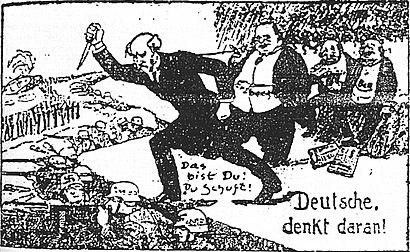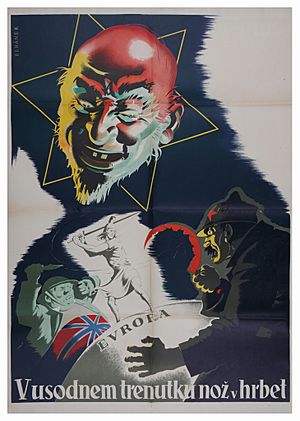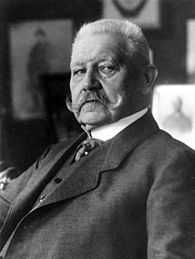Stab-in-the-back myth facts for kids
The stab-in-the-back myth (German: Dolchstoßlegende, meaning "dagger-stab legend") was a false idea that became very popular in Germany after World War I (1914-1918). This myth claimed that the German army did not lose the war on the battlefield. Instead, it said that certain people in Germany betrayed the country from within.
These people were often blamed:
- Jewish people
- Socialists who organized strikes
- Republican politicians who took over the government after the war
People who believed this myth called the German leaders who signed the peace agreement (the Armistice of 11 November 1918) the "November criminals".
When Adolf Hitler and the Nazi Party came to power in 1933, they used this myth a lot. They said the new German government, called the Weimar Republic, was created by these "November criminals" who had "stabbed the nation in the back" to gain power. Nazi messages showed Weimar Germany as a place full of problems caused by Jews and Marxists. They claimed Hitler's movement saved Germany from these issues.
However, historians around the world agree that this myth is completely false. They point out that the German army was running out of supplies and soldiers by late 1918. The entry of the United States into the war also made it impossible for Germany to win. The German army had already lost the war militarily.
Contents
How the Myth Started
In the last part of World War I, Germany was mostly run by its military leaders. General Field Marshal Paul von Hindenburg and his chief-of-staff, Erich Ludendorff, were in charge. They advised Emperor Wilhelm II. Ludendorff was the real power behind the decisions.
The countries fighting against Germany (the Allies) had received many new supplies and fresh soldiers from the United States. Even though German forces were retreating on the Western Front, the Allies had not yet entered Germany itself. On the Eastern Front, Germany had already won against Russia.
After Germany's last big attack on the Western Front failed in 1918, Hindenburg and Ludendorff knew the war was lost. They pushed Emperor Wilhelm II to ask for a peace agreement. They also wanted a civilian government to take over quickly. They started to plan how to blame others for losing the war.
Ludendorff said on October 1, 1918: "I have asked His Excellency to now bring those groups to power whom we have to thank for coming so far. We will therefore now bring those gentlemen into the ministries. They can now make the peace which has to be made. They can eat the broth which they have prepared for us!"
This meant Ludendorff wanted the civilian politicians, many of whom were Socialists, to negotiate the peace. This way, the military leaders would not be blamed for the defeat. Instead, the new civilian government would take the blame. Normally, military commanders sign peace deals. But Hindenburg and Ludendorff gave this job to the new civilian government.
On November 11, 1918, representatives of the new Weimar Republic signed the armistice that ended the fighting. The military leaders had made sure they wouldn't be blamed. Instead, the politicians linked to the armistice, like Matthias Erzberger, were blamed. Erzberger was later murdered because of this false accusation of treason.
The German public had only heard news of victories during the war. Germany itself was not invaded, and its army still held foreign land. So, people were confused when an armistice was requested. They didn't know their military leaders had asked for it, nor that the German army was in full retreat.
This situation created the "stab-in-the-back myth." Hindenburg and Ludendorff were seen as blameless. The German army was believed to be undefeated on the battlefield. The republican politicians, especially the Socialists, were accused of betraying Germany. They were blamed even more after signing the Treaty of Versailles in 1919. This treaty led to Germany losing land and facing huge payments for war damages.
Conservatives, nationalists, and former military leaders criticized the peace and the Weimar politicians. They also targeted socialists, communists, and German Jews. They claimed these groups had not supported the war enough. They were accused of "selling out" Germany to its enemies. These "November Criminals" were seen as having "stabbed them in the back" on the home front. They were accused of criticizing German pride, causing unrest, and organizing strikes in important war industries. These actions, it was believed, stopped Germany from winning at the very last moment.
Where the Myth Came From
Historians say the idea of a "stab in the back" might have first appeared in a sermon in February 1918. However, the exact phrase "stab-in-the-back" became widely known later.
The widespread use of the "stab-in-the-back" myth came from Germany's highest military leaders. In spring 1919, Max Bauer, an army colonel, wrote that the war "was lost only and exclusively through the failure of the homeland."
The specific phrase "stab-in-the-back" might have started in autumn 1919. Ludendorff was talking with a British general, Sir Neill Malcolm. Malcolm asked Ludendorff why he thought Germany lost the war. Ludendorff gave his reasons, including that the home front failed the army.

Malcolm then asked him: "Do you mean, General, that you were stabbed in the back?" Ludendorff loved this phrase. He repeated, "Stabbed in the back? Yes, that's it, exactly, we were stabbed in the back." This is how the legend began.
Ludendorff liked the phrase so much that he made it the "official" story among the military. This helped spread it throughout German society. Right-wing political groups quickly adopted it. Even Kaiser Wilhelm II used it in his memoirs written in the 1920s. These groups used it to attack the early Weimar Republic government.
Even the Social Democratic Party (SPD), which led the new government, accidentally helped the myth. Their leader, Friedrich Ebert, told troops returning to Berlin in November 1918 that "No enemy has vanquished you." He also said, "they returned undefeated from the battlefield." Ebert meant this as a tribute to the soldiers. But it made people believe the army truly hadn't been defeated.
On November 18, 1919, Ludendorff and Hindenburg appeared before a committee investigating the causes of Germany's defeat. Hindenburg refused to answer questions. Instead, he read a statement written by Ludendorff. In his speech, he said: "As an English general has very truly said, the German Army was 'stabbed in the back'." This testimony from Hindenburg made the "stab-in-the-back myth" widely accepted in Germany after World War I.
Antisemitic Ideas
The German Army showed anti-Jewish feelings even before the stab-in-the-back myth became popular. In October 1916, during the war, the army ordered a count of Jewish soldiers. They wanted to show that Jews were not serving enough in the army, especially in fighting roles. But the count showed the opposite: Jews were serving in the army and in fighting positions in proportion to their numbers. The army then hid these results.
Accusations of a Jewish plot in Germany's defeat often focused on people like Kurt Eisner. He was a German Jew who had spoken against the war. He also played a big part in the revolution in Munich before he was killed in February 1919.
The new Weimar Republic government tried to stop workers' uprisings. But its right to rule was constantly attacked with claims like the stab-in-the-back. Many of its leaders, like Matthias Erzberger and Walther Rathenau, were killed. Right-wing newspapers often called them "criminals" and Jews.
Anti-Jewish feelings grew stronger because of the Bavarian Soviet Republic. This was a short-lived communist government in Munich in 1919. Many of its leaders were Jewish. This allowed people spreading anti-Jewish messages to link Jews with Communism and, therefore, with betrayal.

In 1919, a leader named Alfred Roth wrote a book called The Jew in the Army. He claimed that most Jews in the war were only making money or acting as spies. He also blamed Jewish officers for making soldiers feel like they couldn't win. This book was one of the first to publish a version of the stab-in-the-back legend.
German Jewish veterans published a leaflet in 1920 to fight these accusations. It stated: "12,000 Jewish soldiers died on the field of honor for the fatherland." This showed that Jews were indeed patriotic and fought for Germany.
What Happened Next
The "stab-in-the-back" idea was a key part of the messages used by many right-wing political parties in the early Weimar Republic. This included Hitler's Nazi Party. For Hitler, this explanation for World War I was very important. He learned of Germany's defeat while recovering from a gas attack. In his book Mein Kampf, he wrote that this moment inspired him to enter politics. Throughout his career, he often spoke against the "November criminals" of 1918. He claimed they had betrayed the German Army.
World War II

During World War II, the Allies (the countries fighting against Germany) decided on a policy of "unconditional surrender" in 1943. This meant Germany had to give up completely without any conditions. One reason for this was to prevent the "stab-in-the-back myth" from happening again. They wanted the German people to clearly understand that they had lost the war on their own. This way, the defeat couldn't be blamed on a "stab in the back."
Wagnerian Connections
For some Germans, the idea of a "stab in the back" brought to mind Richard Wagner's opera Götterdämmerung. In this opera, a character named Hagen murders the hero Siegfried by stabbing him in the back with a spear. In his own writings, Hindenburg compared the collapse of the German army to Siegfried's death.
Why People Believed It
Historian Richard McMasters Hunt said in 1958 that the myth was an emotional belief for millions of Germans. He suggested that behind these myths was a feeling of shame. Not shame for starting the war, but shame for losing it. Hunt believed it was the shame of weakness that affected Germany's national mood. This feeling helped weaken the Weimar democracy and strengthen Hitler's dictatorship.
Similar Myths in Other Countries
Similar ideas about betrayal after military defeat have appeared in other countries.
- In the United States, some people used a "stab-in-the-back" idea to explain the country's involvement in the Vietnam War.
- In Russia, during the Wagner Group rebellion in 2023, leader Vladimir Putin called the rebellion "a knife in the back of our country." He also compared it to Russia's defeat in World War I after the Russian Revolution.
Images for kids
- Austria victim theory
- Causes of World War II
- Centre for the Study of the Causes of the War
- Defeatism
- Genocide justification
- German Revolution of 1918–19
- Holocaust inversion
- Jewish war conspiracy theory
- More German than the Germans, a contrasting trope about German Jewry.
- Secondary antisemitism
See also
 In Spanish: Leyenda de la puñalada por la espalda para niños
In Spanish: Leyenda de la puñalada por la espalda para niños






